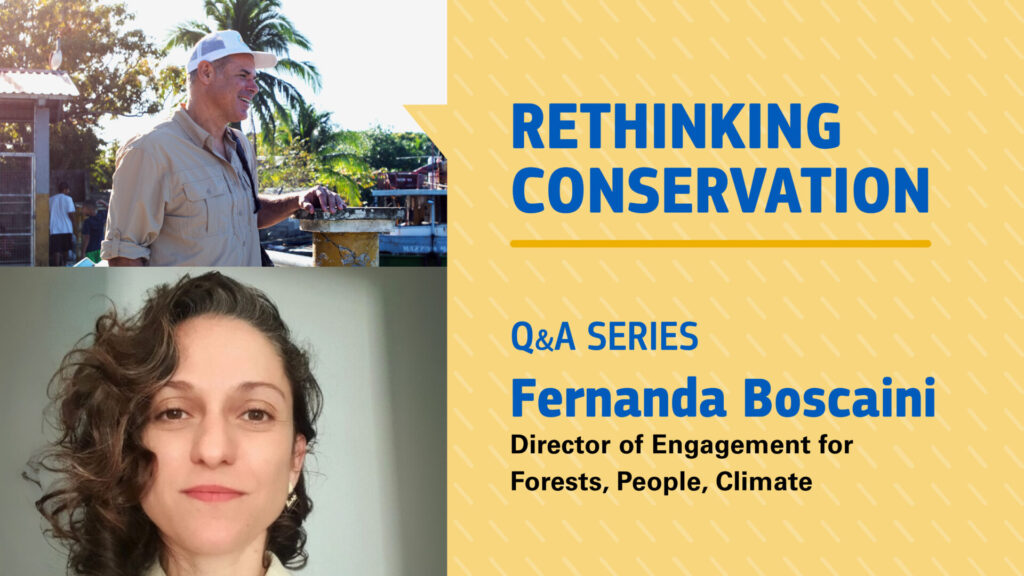
Series note: The following article is part of Rare’s Rethinking Conservation series, highlighting people-centered solutions to the biodiversity and climate crises. Ahead of Climate Week NYC, Rare President Caleb McClennen, Ph.D., interviews Fernanda Boscaini, Director of Engagement for Forests, People, Climate about the big, practical solutions we’re leaving on the table for frontline communities facing climate change’s increasing impacts.
***
As Rare refines its 2030 strategy, I’m asking climate leaders the same three questions: Where are the big climate wins that also improve daily life? Fernanda’s response is below. What follows are her words, verbatim. After each answer, I respond briefly to connect the dots.
– Caleb McClennen
Caleb: Fernanda, thanks for taking the time. As we head into Climate Week, I want to start big. Where do you see the greatest untapped opportunity for culturally-grounded, community-led action to drive climate or conservation breakthroughs — and what’s getting in the way?
Fernanda: Conserving rainforest landscapes is a powerful, scientifically proven solution for climate mitigation. It has multiple climate benefits — not only mitigating emissions but actively processing and storing carbon out of the atmosphere and helping communities be more resilient to a changing climate.
Protecting the rights of forest-dwelling Indigenous Peoples, Afro-descendants, and Local Communities has repeatedly been shown to be the most effective, culturally grounded, community-led action to achieve these climate and conservation objectives.
Yet, there’s a critical gap in climate finance, and these communities receive only a fraction of global funding. This critical shortfall stifles progress, leaving such solutions underfunded and underutilized.
Caleb: This is such a paradox. While there may be no better climate bet than fueling locally led rainforest conservation, there is a bottleneck in getting funding on the ground to those who need it most. The resulting financing gap is massive and a major limiting factor in realizing the benefits of this approach for people and the climate.
Caleb: If you could move $100 million in climate funding tomorrow, where would you put it, and why?
Fernanda: Supporting communities’ leadership and locally driven solutions is essential to slowing emissions globally while advancing equity and sustainability where it matters most. One way to do this is through a collaborative like Forests, People, Climate (FPC), which was built to unlock this potential.
FPC makes it easier for strategic philanthropists to invest significant funding in a portfolio of proven strategies developed in consultation with hundreds of on-the-ground experts and practitioners in the Brazilian Amazon, Congo Basin, and Indonesia — where half of the world’s remaining tropical forests play a vital role in the planet’s health.
This collaborative of philanthropic donors, civil society, and community-based organizations focuses on equitable and enduring solutions that safeguard tropical forests and support the communities living within them. With philanthropic leadership, these transformative solutions can be scaled to deliver even more measurable impact — cutting emissions, preserving biodiversity, and building a more sustainable, equitable future.
Caleb: I have been inspired by FPC’s early investments in providing catalytic and flexible resources to back rights-based strategies across the Amazon, Congo, and Indonesia. We think similarly at Rare about how we can best support community outcomes for both climate and people. The role of the global organization is changing as well. We are keen to learn how we can best make an impact supporting communities and people on the frontline, recognizing that the more direct access to funding for them, the better.
Protecting the rights of forest-dwelling Indigenous Peoples, Afro-descendants, and Local Communities has repeatedly been shown to be the most effective, culturally grounded, community-led action to achieve these climate and conservation objectives.
Caleb: Ok, last question: What emerging idea, movement, or actor gives you the most hope for climate action today?
Fernanda: Many people are familiar with the concept of an “Urban Heat Island”, and know that cities can be cooler, more livable, and more resilient to a changing climate by investing in greening buildings and streets.
Many people don’t know that a similar threat and opportunity exist in more rural landscapes, too. Deforested lands, bare of natural forests, are more exposed to extreme heat and weather, threatening farms growing food and rural communities. Protecting forests and actively restoring natural landscapes can protect our food supply and innumerable communities while mitigating global carbon emissions.
In other words, local action can protect communities, give an opportunity and reason to act, and lead to focused local approaches that have a high impact with a clear, proven return on philanthropic investment.
Caleb: I appreciate that frame. It brings the benefits close to home: cooler microclimates, safer water, stronger livelihoods — and a global emissions payoff as a result. The health angle to climate and conservation cannot be understated. It is the entry point for so many people into the environmental dilemma, and often the one with the greatest immediate impact.
Taken together, your answers point to a simple focus for global actors in the climate space: Fund community leadership, back rights-based stewardship of standing forests, and measure what matters to people — dignity, income, resilience, and nature, alongside carbon. Thanks for your insightful responses.
Follow Caleb McClennen on LinkedIn for more insights into Rethinking Conservation.